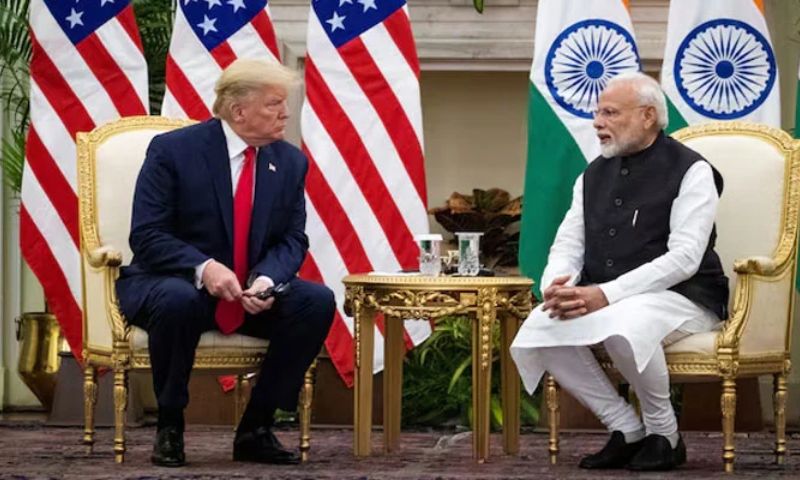Key points
- Key Indian sectors such as textiles, gems, and auto parts risk severe profit hits
- India runs a $45.7b surplus with the US — a core grievance driving US pressure
- Rising tensions could strain broader US-India ties amid shared concerns over China
ISLAMABAD: With the US set to impose 25 per cent tariffs on Indian exports from August 1, India’s key industries face major profit hits, raising economic and diplomatic stakes amid stalled trade talks.
The United States is poised to impose a 25 per cent tariff on Indian imports, escalating a months-long standoff over trade negotiations.
“They are going to pay 25%,” President Donald Trump said Tuesday, reiterating his tough stance, according to CNN.
Despite multiple rounds of dialogue, Trump warned, “India has been – they’re my friends,” but added, “You’re not treating us right.”
25pc tariff threat
Indian exporters are preparing for a steep tariff hike on exports to the US, as President Donald Trump on Tuesday warned that India could face a 20–25% tariff from August 1. “Only a miracle can make it happen,” said Ajay Sahai, head of the Federation of Indian Export Organisations, referring to a last-minute trade deal, according to AFP.
Volume of bilateral trade
Trade between the US and India reached $130 billion last year, according to The New York Times.
The US imported $87 billion worth of goods from India, while India bought $42 billion in American exports, CNN noted. The imbalance remains a key concern for Trump, who has long aimed to reduce US trade deficits.
Despite not being a manufacturing giant, India ran a $45.7 billion trade surplus with the US last year, according to AFP. The United States is a key export destination for Indian products, particularly in labour-intensive sectors.
Impact on Indian economy
The tariff hike is expected to hit profit margins for both exporters and US importers. “Both sides will share the hit,” Sahai told AFP. Apparel council head Sudhir Sekhri warned that with razor-thin margins in textiles and garments, “we can’t afford that kind of a hit.”
The potential tariff could strike at the heart of India’s export-driven sectors. “India runs a surplus with the United States that any new tariff would most likely reduce,” according to The New York Times. With global companies such as Apple shifting manufacturing to India, the country risks losing its competitive edge if US tariffs rise above those on countries such as Vietnam.
Products and services at risk
Sectors like textiles, garments, gems and jewellery, and shrimp exports are at risk. “Order flow from Europe has also gone down,” Sekhri added, citing increased Chinese competition in Europe due to US tariffs on China, according to AFP.
Among India’s top exports to the US are pharmaceuticals, auto parts, electrical goods, apparel, and gemstones. These industries face direct exposure to tariffs, and a separate 25 per cent auto parts tariff already threatens India’s auto sector, according to The New York Times. Trump has also targeted Indian digital services and regulatory barriers that affect US tech and agricultural firms.
Wider issues at stake
The looming tariffs are disrupting supply chains and market confidence, especially for small and medium enterprises that depend heavily on US buyers. Exporters are scrambling to restructure pricing and contracts to stay afloat, according to AFP.
Beyond economics, the standoff could reverberate geopolitically. “The stakes are high, with the United States and India counting on each other as indispensable partners in their competition with China,” according to The New York Times report. With strategic and defence cooperation in play, India’s invitation for Trump to attend a fall summit may be an attempt to salvage broader ties.
Contentious issues in talks
Talks have stalled over the US demand for greater access to India’s agriculture and dairy markets, which New Delhi has resisted, according to AFP
The most disputed issues include high Indian tariffs, non-tariff barriers, and import testing requirements. Trump called India “the tariff king,” while CNN cited the White House’s frustration with India’s taxes on digital services. “They charge more tariffs than any other country,” Trump said. Additionally, Indian agriculture remains deeply protective of its domestic market.
US expectations
US Trade Representative Jamieson Greer has said that “more negotiations” were necessary, questioning “how ambitious” India is willing to be in trade reform, according to CNBC. A CNN report cites Greer as saying, “They have expressed strong interest in opening portions of their market… But I think we need some more negotiations.” Trump’s team wants greater access to India’s consumer base, fewer restrictions, and ideally zero tariffs on US goods — a claim India has contested.
What India expects
India seeks reciprocity. Some exporters “would like to ‘zero out’ their tariffs with the United States,” according to The New York Times. Commerce Minister Piyush Goyal described negotiations as “making fantastic progress” and remains hopeful a bigger deal can be struck during Trump’s possible fall visit. But India’s farmers and domestic industries remain wary of foreign competition.
According to AFP, with both sides aiming for a broader trade deal by October, the coming weeks may prove pivotal in reshaping the future of India-US trade.
























